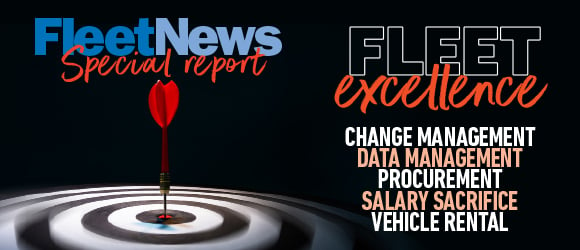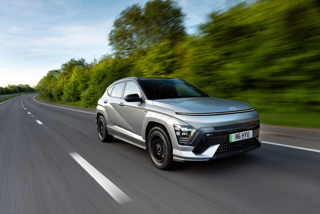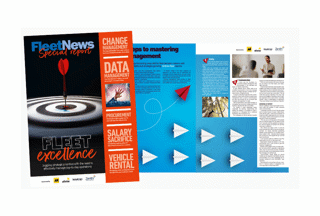This article has been taken from the latest Fleet News special report Fleet Excellence. It is sponsored by The AA, Allstar and Keyloop.

Fleet procurement is not the cut and dried process where a buyer simply negotiates a price for a product and gets it fixed for a couple of years.
There are many elements, most of them variable, which makes the task a complex exercise requiring expertise and insight.
“Too often fleet is viewed as just another commodity purchase, with the focus solely on price,” says Simon Staton, client management director at Venson Automotive Solutions, which published its Tackling Fleet Procurement Challenges Head-on white paper earlier this year.
“Unlike buying office stationery, for example, fleet procurement is a financial deal that often involves vehicles or a range of in-life services. It’s certainly not black and white.
“It is crucial that anyone involved in the procurement process fully understands what they are buying, and that the variables that make up the price are dynamic and can change during the lifetime of a contract.”
There may be many reasons why a fleet would put a contract out to tender.
These include searching for a new supplier, their business operations may mean they are obliged to go out to tender, they could be benchmarking the market or seeking leverage with an existing supplier.
A well-run tender process gives a fleet an opportunity to find the right long-term partner, one that understands the company’s objectives, provides transparent and sustainable pricing and fits with their culture.
Procurement processes will differ between organisations and will depend on business model, company size, location, company structure, human resources, budget and spending, but there are some common factors between all of them.
Here we outline the five key steps needed for a successful process.
1 Do your homework
It is important for a fleet to build a relationship with potential suppliers before the formal tender process begins.
“They should get to know the providers they are considering,” says Christopher Caddick, head of business development at JCT600 Vehicle Leasing Solutions.
“Understand their culture, meet their people and test the working relationship before the process begins.
“Cultural fit, mutual trust and confidence in a partner’s approach can be as important as price.
“A tender process entered into with little prior understanding between the two parties often leads to misalignment, disappointment and missed potential on both sides.”
A high-level understanding of the marketplace is also needed by the fleet decision-maker if the right suppliers are to be asked to tender.
Important information which can be used to identify suitable suppliers can be garnered from the fleet press – particularly Fleet News – as well as talking to peers, attending Association of Fleet Professionals (AFP) meetings and industry networking.
The fleet should also involve the incumbent provider and discuss with them the reasons for the tender exercise, such as any procedures that could be improved on and new services required.
“It is therefore a good idea that a pre-qualification stage embracing a request for information (RFI) from potential suppliers should then be weighted and scored to enable a shortlist to be compiled who will then respond to the formal tender document,” says Venson.
“Such research will result in a targeted tender exercise being carried out involving potential suppliers that are likely to be able to deliver, with those that have failed to impress having been screened out.”
David Savage, chief revenue officer at Lightfoot, warns skipping market research or early-stage trials can be a costly oversight.
“With many providers offering similar-sounding features, it’s critical to validate real-world performance, measure driver engagement, assess cultural alignment and confirm ROI,” he says.
“The best outcomes occur when the tender process is treated not as a transaction, but as the beginning of a long-term partnership.”
2 Be clear on what you want
One of the most common – yet avoidable – mistakes made during a fleet procurement process is a lack of clarity on objectives/scope, says Caddick, of JCT600 Vehicle Leasing Solutions.
“Organisations need a clearly defined set of objectives or a detailed understanding of what matters most, not only in fleet, but in the wider context of their business strategy,” he adds.
“Without a clear scope of services, key performance priorities and a structured set of questions, the responses received are unlikely to be aligned with the business’s true needs.
“The format of the tender questions is also key as it can lead to inconsistent responses, making it difficult to benchmark providers effectively or make informed decisions.”
It is crucial to involve a range of personnel in the procurement process as they can give vital insight to ensure an appropriate document is compiled.
An organisation’s procurement department may well take the lead in the process, but the input of the fleet team is vital.
“We have found some tender documents to be concise, to the point and generally well-written,” says Venson.
“However, others have been written by people with little to no knowledge of either the fleet their organisation operates or the wider fleet market.”
Know what you want and articulate that clearly. Asking a potential supplier to respond to precise operational scenarios enables them to fully detail the actions they would take and gives the opportunity to compare and contrast in the real world.
3 Determine what value means to you
“One of the crucial points to remember is that value for money should never be mistaken for the lowest price,” says Staton, of Venson Automotive Solutions.
“There’s so such thing as a ‘golden deal’. It is essential to think of the contract in its entirety, taking into consideration factors such as rate creep, including end-of-contract charges and damage waiver fees.
“Additionally, there’s a need to account for current and emerging technology to be factored in.
“Fleet decision-makers should always opt for transparency in a contract that considers long-term value, rather than short-term gain.”
Prizing price above all else will mean numerous critical elements will be ignored, warns Savage, of Lightfoot.
These could include warranties, support or performance guarantees, ultimately costing more over the contract’s lifetime.
“Often a solution that appears more expensive initially can deliver two to four times the ROI,” he adds.
“Another pitfall is focusing too heavily on product features rather than tangible value and outcomes a solution can deliver.
“We frequently see tenders that are overly price driven. Cost is always a factor, but an excessive focus on upfront pricing can push fleets towards commodity solutions that lack long-term value.”
Staton recommends that when scoring a tender, price should account for no more than 40% of the score. Allocating a greater proportion makes price too important.
4 Assessing tenders takes a balanced view
How organisations weigh up the importance of the different factors such as value for money, quality, reliability and service, will depend on business priorities and strategy.
Taking a full balanced score card approach, appropriately weighted and measuring key criteria including capability, risk, financial stability and ESG issues as well as value for money and price will, if done properly, ensure that the organisation with the highest score will win the contract.
As mentioned in the previous section, when evaluating a tender, price should account for no more than 40% of the score.
Weighting the tender more than 50% for price – unless it is a very simple commodity – is missing a trick and making price too important. Staton says some suppliers are prepared to pay a ‘signing on fee’ or a so-called ‘golden hello’ to win fleet business, but leasing and fleet management companies offering such incentives are likely to retrieve the cost of any such payment during the lifetime of the contract.
“There is not a lot that is ‘fixed’ in a vehicle leasing contract,” says Staton. “In short, nothing is ‘free’ and the reasons that vehicle leasing and fleet management companies offering such incentives will find for changing prices are all legitimate.
“Procurement managers and their colleagues may award a contract believing that they have locked down a deal and secured a golden hello, but it will invariably prove to be a false economy.
“It is critical that, if quotes obtained are out of line with the market, then the question that must be asked is ‘why?’.
“If the price is considerably lower, the answer is almost certainly that a supplier is attempting to buy business at a price that will be unsustainable across the lifetime of the contract.
“As a result, the perceived saving will evaporate and will, likely, become a cost.”
Fleets should provide a clear and consistent pricing matrix to enable like-for-like comparisons, but also to promote transparency in understanding the full cost of the services being proposed, says Caddick, of JCT600 Vehicle Leasing Solutions.
“From that point, they need to ask when each pricing component might be subject to change, why and under what conditions, and contract on that basis,” he adds.
“This helps to guard against headline rates that look attractive initially, but are not sustainable or reflective of the long-term costs.”
Other key characteristics which should be looked for when considering tenders are capability, risk, financial stability, ESG issues, speed of response and flexibility, and clear communication.
The final shortlist should contain no more than four suppliers, says Staton.
This means focus can be given to obtaining full and final offers from the companies deemed best-in-class to supply the required services.
Having assessed tender responses, it is important organisations contact the shortlisted suppliers as it gives them the chance to clear up any ambiguities and reshape their answers if necessary.
5 Monitor and review contracts
It is important to have mechanisms in place to ensure that what has been agreed to is supplied to the required standard for the duration of the agreement.
“It can be surprisingly difficult to track contract performance over its full life cycle – particularly when automation and workflow tools are in place,” says Lightfoot’s Savage.
“In many cases, automation streamlines day-to-day operations, but also risks creating complacency. When everything seems to be running smoothly in the background, it’s easy to assume performance is on track – until a problem arises.
“Effective monitoring needs to be proactive, structured and linked to a set of KPIs (key performance indicators).
“These should extend beyond compliance and cost, encompassing service levels, driver engagement, environmental impact and operational efficiency.”
These KPIs should support SLAs (service level agreements) that both parties are happy with and, although they need to be reasonable on both sides, they also need to have teeth and sanctions for failures to perform to agreed standards.
It is important to manage any fleet/supplier relationship through regular meetings and ongoing email or telephone communication as a collaborative partnership will help both parties plan effectively for future needs.
“What is really important is regular open and honest dialogue, to build trust and provide the right environment to work together, as the best outcomes happen when both parties view each other as strategic partners,” says Caddick, of JCT600 Vehicle Leasing Solutions.
“Monitoring is only one aspect. The other is how working in partnership together throughout the contract is an opportunity to continually ask ‘can we deliver this better?’ and challenge the status quo together, explore innovations and adapt to the changing needs of the business and the market.”
Caddick adds the real value in monitoring service delivery lies not just in protecting performance, but in enhancing it.
“A structured, transparent and collaborative approach ensures the contract remains live and dynamic, helping both fleet and supplier grow and improve together,” he says.
“Ultimately, the goal is not just to deliver the service, but to evolve it.”
There are two primary elements to the role of the modern fleet manager: leadership and operational.
Leadership is concerned with strategy, planning, vision, engagement, motivation – everything that ensures the future success of the business.
The operational side is partly about implementation of the plans that help to achieve the strategy, but also about dealing with the day-to-day running of a fleet, such as vehicle issues, driver queries and reporting to key stakeholders.
It’s a difficult balancing act, a tricky drain on time and resource, which can be eased if you are running a fleet team where operational responsibilities can be delegated, of course.
In our Fleet Excellence report, we look at some key elements that cover the full gambit of the fleet manager role, from handling change management and the role of data, to procurement strategies, to the practical elements of implementing and running a salary sacrifice scheme and how rental can play a key role in cost and carbon reduction plans.
The report, sponsored by The AA, Allstar and Keyloop, features advice from many industry experts, while Cadent’s Lucy Stuart, Network Rail’s James Rooney, Openreach’s Abby Chicken and Sureserve’s Stewart Lightbody are among the fleet leaders providing insight about how they implement and manage change.























Login to comment
Comments
No comments have been made yet.